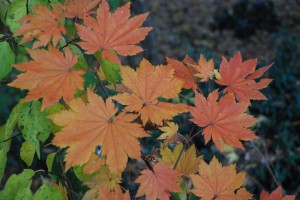The term “full moon Japanese maple” may be confusing. There are actually three species and cultivars of Asian maples that are referred to as “full moon”. The most popular full moon cultivar planted in the Northeast and Southern Appalachian regions (USDA zones 5 thru 7) is Acer japonicum ‘Acontifolium’.
A. j. ‘Acontifolium’ is hardy as far north as Chicago, where it requires winter protection from nearby Lake Michigan (USDA hardiness zone 5). Winter protection is crucial in zone 5, and summer heat protection is key to successfully growing it in zone 7.
A. j. ‘Acontifolium’ grows as a small 15-30 foot tree or multi-stemmed large shrub. It exhibits a spreading or mounding form. During its early years you should stake up the leader to add greater plant height. Branches tend to nod slightly.
Small clusters of reddish purple flowers appear in early to mid- spring, followed by double-winged samaras (seeds). Palmate, almost fern-like green leaves are deeply divided into 9-11 toothed and cut lobes. The circular leaves turn orange to crimson red in the fall.
The soil should be moist and compost rich, planted in full sun in the North (zones 5 -6), and in partial shade in the South (zone 7). Protect against strong winds. Japanese maples are best pruned in summer and early autumn to reduce sap bleeding.
Fertilize in late winter before growth begins with granular 10-10-10 or equivalent. Irrigate shallow rooted Japanese maples during exceptionally long dry spells.


 Posted in
Posted in 
